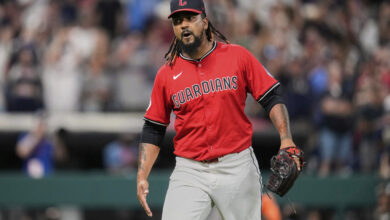
Cards Finally Make A Big Move in Free Agency, Sign…Mike Leake?
They came in second for David Price and Jason Heyward. They lost John Lackey to a division rival. And to top it off, both Heyward and Lackey had actually opted for less guaranteed money¹ elsewhere. The offseason hadn’t been looking too good for the St. Louis Cardinals and GM John Mozeliak had seemingly thrown in the towel, saying that the Cards were no longer looking to make a “dynamic signing.”
But Moze, that sly dog, he was slow-playing us the whole time. This afternoon, it was announced that the Cardinals had locked up Mike Leake for 5 years and $80 million, with a mutual option that could push the deal to 6/$93-94M. Oh, there’s a full no-trade clause too. That’s, uh, well, it’s…a pretty big contract. For a guy who is basically league average.
Seriously, if you had to take one guy and say “this guy is the definition of mediocrity,” it’d be Mike Leake. And that’s not really a knock on him, just a statement of plain fact. That he got $16M AAV from a club that has prided itself on its wise spending is a testament to the value of pitching. It also strikes me as a bit of a desperation move, but perhaps I’m too biased to see it as very savvy.
Leake’s career 3.88 ERA isn’t awful, but his 4.21 FIP tells us that he might have gotten the benefit of luck along the way. Then again, playing in that bandbox in Cincinnati for five and a half years didn’t really do him any favors. As such, Leake’s xFIP, which is a regressed version of FIP that accounts for home run rates and seeks to express how many runs a pitcher should have allowed, is actually 3.81. His SIERA, an even more detailed expression of a pitcher’s performance, is 3.97.
League averages for MLB starters in 2015 looked like this:
- ERA – 4.10
- FIP – 4.03
- xFIP – 4.00
- SIERA – 4.07
By those measures, the new Cardinal does appear to be a little better than average, particularly when you consider that he’s posted ERAs of 3.37, 3.70, and 3.70 the last three seasons. His FIPs in those same seasons, however, were 4.04, 3.88, and 4.20. Huh, that’s right there on the mean.
Leake isn’t a big strikeout guy, boasting just over 6 K/9 for his career, but he doesn’t walk a ton of guys either. His 2.28 BB/9 isn’t what you’d call pinpoint accuracy, but it’s better than the 2.72 MLB starters averaged last season. He keeps the ball on a ground a little better than most and allows fly balls at a lower rate, though his home runs per fly ball percentage (HR/FB%) of 13.7% is a couple ticks higher than most. Again, probably due in part to the conditions at GABC.
Listen, I’m no scout and all I’m really doing here is looking through some numbers, but I just can’t see anything about Mike Leake that justifies the contract the Cardinals just handed him. Well, other than maybe his 3.50 ERA in 6 Busch Stadium starts. Mozeliak certainly wasn’t high on Leake’s 4.20 ERA in 10 starts at Wrigley. Or maybe he was. High, I mean.
What this deal tells me is that the pitching market is crazy and that the Cardinals felt this was the price they had to pay to fill out their rotation. It also tells me that the Cubs and their fans can feel pretty darn good about having Kyle Hendricks in that 4/5 role. Hendricks is appreciably better than Leake across the board — seriously, he’s better in pretty much every single category — and he’s making about $15.5 million less. Now, that does bring up the potential quandary of having to pay for his services eventually, but that won’t be an issue for another five years.
You always feel good when you’ve got your opponent down in the count and battling with two strikes, and that’s exactly what this struck me as. After missing on their top targets, the Cardinals had to get defensive. On the other hand, it can be dangerous to back a wounded animal into a corner. Furthermore, there’s no telling what will happen when Leake drinks deeply of the magic voodoo potion in St. Louis.
But rabies and necromancy aside, I just don’t see how this serves to make the Cardinals a better team. Perhaps the rigors of a 162-game season will prove otherwise, but the more the offseason drags on, the more it appears the Cubs are continuing to gain on their rivals.
¹In Heyward’s case, the pair of opt-outs the Cubs built in were surely a big part of the decision, as he can get back on the market in 3 or 4 years when he’s still very much in his prime.

